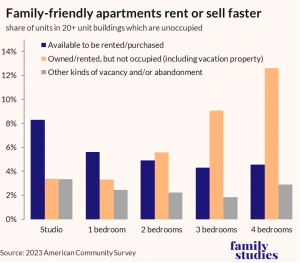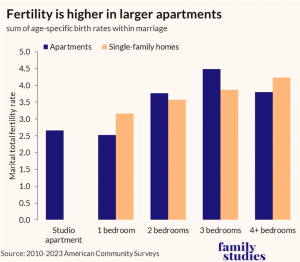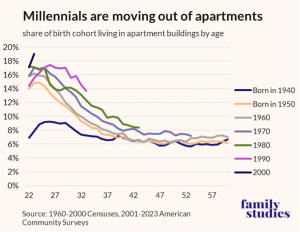New Survey: Families Will Pay For Family-Friendly Apartments
Bigger apartments could boost fertility, lower vacancies, and strengthen long-term returns.
Developers are leaving money on the table by ignoring family-sized units.”
CHARLOTTESVILLE, VA, UNITED STATES, September 30, 2025 /EINPresswire.com/ -- A new survey reveals a housing-market blind spot: bigger apartments could boost fertility, lower vacancies, and strengthen long-term returns.— Bobby Fijan
A groundbreaking national survey of more than 6,000 Americans finds that demand for family-friendly apartments far outstrips supply—and that families are willing to pay for them, though they would prefer a house. The report, Homes for Young Families: Americans Are Willing to Pay for Family-Friendly Apartments, published by the Institute for Family Studies (IFS), shows that America’s apartment boom is overlooking the needs of young families, with consequences for developers, policymakers, and the nation’s demographics.
APARTMENT BOOM, SHRINKING UNITS
Since the Great Recession, apartments have surged as a share of U.S. housing construction. In 2024, more than one-third of all new housing units were in large apartment buildings, the highest rate in fifty years. Yet while supply is growing, family-friendly design is disappearing. Average unit size has dropped by 20% since 2007, and just 5% of new apartments today include three or more bedrooms.
“Young Americans are spending more of their prime childbearing years in apartments,” said report co-author Lyman Stone. “If those apartments aren’t designed with families in mind, it’s no surprise fertility rates suffer.”
BEDROOMS DRIVE DEMAND
The IFS survey asked Americans to rank specific apartment floorplans and amenities. The results were unambiguous: bedrooms matter more than any other factor.
- Layout matters. At the same square footage, units with more bedrooms were rated more family-friendly.
- Willingness to pay. The difference between a two-bedroom and four-bedroom apartment influenced renter choice as much as a $1,500 rent change.
- Vacancy and turnover. Studios have nearly twice the vacancy rate of three-bedroom units, while smaller units generate higher turnover and missed payments.
> Figure: Vacancy rates by bedroom count in apartments in buildings with 20+ units
“Developers often focus on rent per square foot,” said co-author Bobby Fijan. “But the real story is effective returns. Larger units mean lower vacancies, longer leases, and more reliable tenants. Builders are leaving money on the table.”
HOUSING AND FERTILITY
The study also finds that housing design shapes family formation. Married women living in two- and three-bedroom apartments have higher birth rates than those in smaller units—and in some cases higher than those in comparable single-family homes. Nearly half of respondents who favored larger floorplans explicitly cited additional bedrooms as the reason they would feel more confident having a child.
> Figure: Marital total fertility rates for U.S. women residing in apartments by bedroom count
“Suitability, not just affordability, drives family decisions,” said Stone. “If young couples can’t find apartments that fit their aspirations, they delay childbearing. That’s a headwind for the nation’s future.”
POLICY AND MARKET SOLUTIONS
The report identifies concrete steps for both developers and policymakers:
**Developers and Investors**
- Add more three-bedroom units to large projects.
- Adjust investment metrics to reflect lower turnover and vacancy in family-sized units.
- Explore construction innovations that make smaller-scale, family-friendly projects viable.
**Policymakers**
- Set parking requirements per unit, not per bedroom.
- Expedite permitting for smaller projects that allow design flexibility.
- Update codes to allow single-stair buildings up to four stories.
- Direct housing trust funds to prioritize bedrooms built, not just units.
A WINDOW OF OPPORTUNITY
The authors warn that developers risk oversupplying small apartments just as the millennial generation ages out of peak apartment years. Family-friendly units, by contrast, hold their value as renters age.
> Figure: Share of birth cohort living in buildings with 10+ units by age
“America’s apartment boom isn’t going away,” said Fijan. “But if we align construction with what families actually want, everyone wins: families, policymakers, and investors.”
**About the Report**
Lyman Stone, Bobby Fijian, “Homes for Young Families: Americans Are Willing to Pay for Family-Friendly Apartments” (Institute for Family Studies, September 29, 2025).
The Multifamily Housing Survey was fielded in May 2025 by Demographic Intelligence and The American Housing Corporation.
Contact:
Institute for Family Studies
media@ifstudies.org
ifstudies.org
x.com/famstudies
Pull-Quotes
“Bedroom counts are the sine qua non of family-friendly housing.” — Bobby Fijan
“Suitability, not just affordability, drives family decisions.” — Lyman Stone
“Developers are leaving money on the table by ignoring family-sized units.” — Bobby Fijan
“If apartments aren’t designed with families in mind, fertility rates will continue to fall.” — Lyman Stone
“Family-friendly apartments mean lower vacancies, longer leases, and more reliable rent payments.” — Bobby Fijan
“America’s apartment boom isn’t going away—but it must be made family-friendly.” — Bobby Fijan
“When young families can’t find suitable housing, they delay childbearing. That’s a demographic headwind.” — Lyman Stone
Christopher Bullivant
Institute for Family Studies
+1 202-890-7002
email us here
Legal Disclaimer:
EIN Presswire provides this news content "as is" without warranty of any kind. We do not accept any responsibility or liability for the accuracy, content, images, videos, licenses, completeness, legality, or reliability of the information contained in this article. If you have any complaints or copyright issues related to this article, kindly contact the author above.



